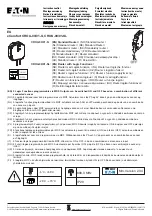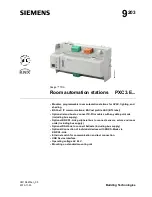
Operation
8
Xanura is a system that is easy to apply. Because
use is made of the (existing) lighting network,
investment of time and money for a special network
is not necessary. To give an insight into how the
system works, a step-by-step explanation of
Xanura is given below.
Astute use of the existing lighting network
When applying Xanura, use is made of the existing
lighting network infrastructure. For communication via
this network, Xanura modules are applied. These
communicate with each other by means of the A10
protocol.
The Xanura basis
The basis of Xanura comprises built-in modules
that are located in the junction boxes situated
behind wall sockets and light switches. In principle,
there are two types of modules: actuators and
(switch) interfaces.
* Actuators are switching components that are
situated behind either the wall socket junction
boxes, wall switches, in central junction boxes
or appliances.
* (Switch) interfaces are situated behind wall
switches and send commands over the
lighting network.
Receipt over the complete lighting network
For communication via the lighting network, use is
made of the phase and neutral wires. When an Xanura
command is sent, this signal is received by the whole
lighting network, even if a module is located in another
group.
Schematic illustration of application of built-in modules.
Seeing that all Xanura components are provided
with an address during installation, only the specific
receivers (actuators) will carry out the desired actions.
Invisable mounting
Thanks to their compact design (45x45x16mm),
Xanura modules can be mounted behind wall sockets
and switches without being visible.
Switching actuators
Two types of switching actuator modules are available
for application with Xanura, i.e. one for mounting
behind wall junction boxes and another for behind wall
switches. These actuators react with a switching action
when Xanura commands are created by interfaces.
Hybrid switching technique
The hybrid switching technique applied in the
switching actuators makes it possible to operate
them with a current of 16 A. This is the case for
not only the resistive*
1
and inductive*
2
loads but also
for capacitive*
3
loads. Switching in the modules is
provided by a combination of a relay and a
semiconductor component, whereby the risk of
"welding" of the relay contacts is a thing of the past.
Furthermore, this design makes it possible to keep the
housing very compact. This switching technique, that
has been developed by Eaton Holec for house
automation applications, was patented in 2002.
*
1
Light bulb. *
2
Motors and halogen lighting with
conventional transformers.
*
3
Energy-saving light bulbs and fluorescent lamps.
Switch interfaces
The switch interface is mounted in the junction box
behind the wall switch. Switch interfaces "translate" an
action - e.g. pressing the switch or pulse switch
into an Xanura command that is then sent via the
lighting network. Only the specific switch actuator with
the correct address reacts to the command. In this
way, it is possible to select a simple on/off function or
a circuit interface that can control different switch
actuators simultaneously.
Remote control
To operate Xanura by remote control, the Xanura
remote control device can be used. This can be done
from any position in the home due to the fact that RF
signals (radio frequency) travel through walls and
Operation
N
Prog.
Adres
AIX
N
N
N
Adres
SAX1
Prog.


































